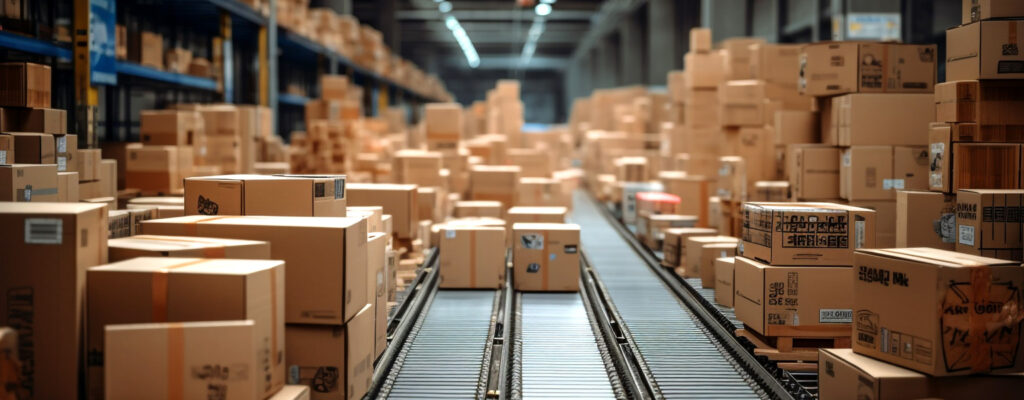
Warehousing and distribution services involve the management of storage facilities and the movement of goods to ensure efficient and timely delivery to customers. These services are essential components of the supply chain and play a crucial role in meeting customer demands and optimizing inventory management. Here’s an overview of warehousing and distribution services:
Warehousing Services
- Storage : Providing storage facilities to store inventory, raw materials, components, and finished goods in a safe, secure, and organized manner.
- Inventory Management : Managing inventory levels, tracking stock movements, and optimizing warehouse space utilization to ensure sufficient stock availability while minimizing holding costs and stockouts.
- Order Fulfilment : Processing customer orders, picking, packing, and preparing goods for shipment based on order requirements and delivery instructions.
- Receiving and Inspection : Receiving incoming shipments, inspecting goods for damage or discrepancies, and verifying quantities against purchase orders and packing lists.
- Quality Control : Conducting quality checks, inspections, and audits to ensure that goods meet quality standards and specifications before storage or shipment.
-
Value-added Services : Offering additional services such as labelling, packaging, kitting, assembly, and customization to meet specific customer requirements and add value to products.
Distribution Services
- Transportation : Arranging transportation services to move goods from warehouses or distribution centres to customer locations using various modes of transport such as trucks, trains, ships, and airplanes.
-
Route Optimization : Planning and optimizing delivery routes to minimize transportation costs, reduce transit times, and maximize efficiency in distribution operations.
-
Last-Mile Delivery : Managing the final leg of the delivery process, including local delivery, home delivery, and doorstep delivery to reach end customers in residential or remote areas.
-
Tracking and Tracing : Providing real-time visibility and tracking of shipments throughout the distribution process, enabling customers to monitor the status and location of their orders.
- Cross-Docking : Facilitating the direct transfer of goods from inbound to outbound shipments without storing them in the warehouse, reducing handling costs and transit times.
-
Reverse Logistics : Managing returns, exchanges, and product recalls by handling reverse logistics processes, including product retrieval, inspection, refurbishment, and disposal.
Value-added Distribution Services
- Order Management : Managing order processing, inventory allocation, and order fulfilment activities to ensure accurate and timely order processing and delivery.
- Supply Chain Integration : Integrating distribution services with other supply chain functions such as procurement, manufacturing, and sales to achieve seamless coordination and collaboration.
- Vendor Managed Inventory (VMI) : Collaborating with suppliers to manage inventory levels and replenishment processes based on agreed-upon inventory targets and consumption patterns.
- Just-In-Time (JIT) Delivery : Providing JIT delivery services to deliver goods to customers precisely when needed, minimizing inventory holding costs and improving supply chain responsiveness.
Technology and Automation
-
Warehouse Management Systems (WMS) : Implementing WMS software to automate warehouse operations, optimize inventory management, and improve order accuracy and efficiency.
-
Transportation Management Systems (TMS) : Utilizing TMS software to optimize transportation routes, consolidate shipments, and track transportation costs and performance.
- Barcode and RFID Technology : Using barcode scanning and RFID (Radio Frequency Identification) technology to track inventory, improve inventory accuracy, and streamline warehouse operations.
- Automation and Robotics : Deploying automation and robotics solutions such as automated storage and retrieval systems (AS/RS), conveyor systems, and robotic picking systems to enhance warehouse efficiency, speed, and accuracy.
Overall, warehousing and distribution services play a critical role in the supply chain by providing storage, handling, and transportation solutions to ensure the efficient flow of goods from suppliers to customers. By outsourcing warehousing and distribution services to experienced third-party logistics providers (3PLs) or leveraging advanced technology solutions, businesses can optimize their supply chain operations, improve customer service levels, and gain a competitive advantage in the marketplace.
Distribution and warehousing are essential components of the supply chain process. Distribution involves the efficient movement and delivery of goods from manufacturers or suppliers to end-users or customers. It encompasses activities such as transportation, order fulfillment, and inventory management to ensure products reach their intended destinations in a timely and cost-effective manner. Warehousing, on the other hand, involves the storage and management of inventory at distribution centers or warehouses. Warehouses serve as hubs for storing, sorting, and organizing goods before they are distributed to customers, providing a central location for inventory management, order processing, and shipment consolidation. Together, distribution and warehousing play a critical role in ensuring the smooth flow of goods through the supply chain from production to consumption.
Warehousing services encompass a range of activities and functions related to the storage and management of goods within a warehouse facility. These services include inventory management, receiving and unloading shipments, storage and shelving of goods, order picking and packing, loading and shipping of goods, inventory tracking and control, and value-added services such as labeling, repackaging, and kitting. Warehousing services are designed to help businesses efficiently store and manage their inventory, optimize logistics operations, and meet customer demand effectively.
The four main types of warehouses and distribution centers are:
- Public Warehouses : These are facilities owned and operated by third-party logistics providers (3PLs) that offer storage and distribution services to multiple businesses on a rental basis.
- Private Warehouses : These are facilities owned and operated by individual companies to store their own inventory and manage their distribution operations exclusively.
- Distribution Centers : These facilities specialize in receiving, storing, and shipping large volumes of goods to fulfill customer orders quickly and efficiently. They often serve as hubs in the supply chain network.
- Climate-Controlled Warehouses : These warehouses are equipped with temperature and humidity controls to store goods that require specific environmental conditions, such as perishable items, pharmaceuticals, or electronics.
Contact us at the Consulting WP office nearest to you or submit a business inquiry online.
Consulting WP really helped us achieve our financial goals. The slick presentation along with fantastic readability ensures that our financial standing is stable.


